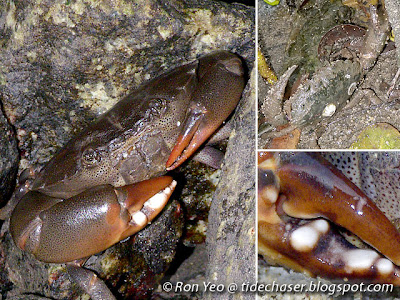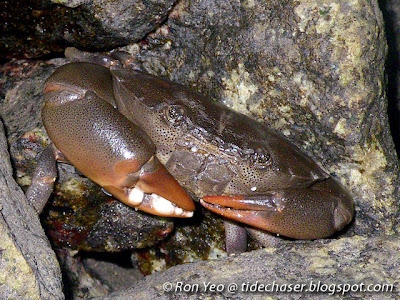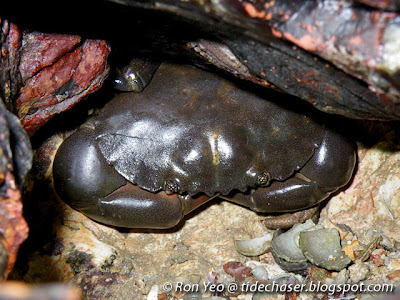Forceps crabs (phylum Arthropoda, subphylum Crustacea, class Malacostraca, order Decapoda, superfamily Eriphioidea, family Oziidae) typically have asymmetrical chelipeds (i.e. the clawed arms), with the larger one having a gently curved tooth at the base of the top finger, and the smaller cheliped with slender fingers, much like a pair of forceps.

The curved tooth is for cutting a channel into the opening of snails (much like a can-opener as the crab turns the shell to cut a channel), while the forceps-like pincers extract the exposed flesh. Some species may develop a molariform tooth as the crab matures, which allows the crab to crush the shells of both molluscs and crustaceans. The carapace may be hexagonal or ovate, the front half of the margin is lined with numerous teeth. Forceps crabs are usually found hiding among rocks or roots.
Like other true crabs, forceps crabs have a broad carapace, and a very short and flattened abdomen which is usually folded underneath the body. They also have five pairs of "legs" (including the clawed arms, or chelipeds), and hence they are placed in the order Decapoda ("deca" means "ten", while "poda" means "feet"). The gills are leaf-like - a distinctive characteristic of decapods from the suborder Pleocyemata. And as with other crustaceans from the class Malacostraca, their body comprises three main parts - a head with five segments, a thorax with eight segments, and an abdomen with six segments. The head is fused to the thorax, forming a cephalothorax. They have a tough exoskeleton strengthened with calcium carbonate, and the carapace covers the gills but not the abdomen.
Forceps crabs reproduce sexually, and have separate sexes. They mate face-to-face, usually with the male on top and the female below. The females can usually be distinguished from the males by having a broader abdomen. This is an adaptation to allow them to carry the eggs under their abdomen until they hatch.
Forceps crabs are sometimes confused with rubble crabs (family Xanthidae), mud crabs (Scylla spp.), and other crabs of the same superfamily Eriphioidea [such as stone crabs (family Menippidae) and red-eyed crabs (family Eriphiidae)]. Unlike rubble crabs, forceps crabs have the large curved tooth near the base of the top finger of the bigger pincer. They can be easily distinguished from the mud crabs by the lack of paddle-like back legs found in the latter. They can also be distinguished from other crabs of the superfamily Eriphioidea by having thin and long fingers (hence forceps-like) on the smaller chelipeds.
Here are some of the forceps crabs that can be seen Singapore.

The Mangrove Forceps Crab (Epixanthus dentatus) can usually be recognised by the orange spots on its back, except that it is sometimes covered in mud. In such situations, it may be easier to recognise it by its thin and forceps-like smaller claw, and a larger claw with a curved tooth at the base of the upper finger. Studies have shown that it feeds on both crustaceans and shelled molluscs. It uses its large claw with the curved tooth like a can-opener to cut a channel on the shell of its prey or crush the shell altogether, and uses the smaller claw to extract the exposed flesh.

The above photo features the front view of a Mangrove Forceps Crab. This species is usually found hiding under driftwood or among the roots in mangrove forests. It is sometimes collected for consumption by villagers. The maximum carapace width is about 8cm.

The Spotted-belly Forceps Crab (Ozius guttatus) is usually found on rocky shores, and can be easily recognised by the numerous tiny spots marking its underside. It feeds mostly on snails, and sometimes, other crustaceans. Like the previous species, it can use the curved tooth on the upper finger of the larger claw like a can-opener to cut a channel into the opening of snails, and then extract the exposed flesh with the smaller, forceps-like claw.

The above features a Spotted-belly Forceps Crab hiding among the rocks. This species is sometimes collected by hand for consumption. The carapace can get to about 9cm wide.
References

The curved tooth is for cutting a channel into the opening of snails (much like a can-opener as the crab turns the shell to cut a channel), while the forceps-like pincers extract the exposed flesh. Some species may develop a molariform tooth as the crab matures, which allows the crab to crush the shells of both molluscs and crustaceans. The carapace may be hexagonal or ovate, the front half of the margin is lined with numerous teeth. Forceps crabs are usually found hiding among rocks or roots.
Like other true crabs, forceps crabs have a broad carapace, and a very short and flattened abdomen which is usually folded underneath the body. They also have five pairs of "legs" (including the clawed arms, or chelipeds), and hence they are placed in the order Decapoda ("deca" means "ten", while "poda" means "feet"). The gills are leaf-like - a distinctive characteristic of decapods from the suborder Pleocyemata. And as with other crustaceans from the class Malacostraca, their body comprises three main parts - a head with five segments, a thorax with eight segments, and an abdomen with six segments. The head is fused to the thorax, forming a cephalothorax. They have a tough exoskeleton strengthened with calcium carbonate, and the carapace covers the gills but not the abdomen.
Forceps crabs reproduce sexually, and have separate sexes. They mate face-to-face, usually with the male on top and the female below. The females can usually be distinguished from the males by having a broader abdomen. This is an adaptation to allow them to carry the eggs under their abdomen until they hatch.
Forceps crabs are sometimes confused with rubble crabs (family Xanthidae), mud crabs (Scylla spp.), and other crabs of the same superfamily Eriphioidea [such as stone crabs (family Menippidae) and red-eyed crabs (family Eriphiidae)]. Unlike rubble crabs, forceps crabs have the large curved tooth near the base of the top finger of the bigger pincer. They can be easily distinguished from the mud crabs by the lack of paddle-like back legs found in the latter. They can also be distinguished from other crabs of the superfamily Eriphioidea by having thin and long fingers (hence forceps-like) on the smaller chelipeds.
Here are some of the forceps crabs that can be seen Singapore.

The Mangrove Forceps Crab (Epixanthus dentatus) can usually be recognised by the orange spots on its back, except that it is sometimes covered in mud. In such situations, it may be easier to recognise it by its thin and forceps-like smaller claw, and a larger claw with a curved tooth at the base of the upper finger. Studies have shown that it feeds on both crustaceans and shelled molluscs. It uses its large claw with the curved tooth like a can-opener to cut a channel on the shell of its prey or crush the shell altogether, and uses the smaller claw to extract the exposed flesh.

The above photo features the front view of a Mangrove Forceps Crab. This species is usually found hiding under driftwood or among the roots in mangrove forests. It is sometimes collected for consumption by villagers. The maximum carapace width is about 8cm.

The Spotted-belly Forceps Crab (Ozius guttatus) is usually found on rocky shores, and can be easily recognised by the numerous tiny spots marking its underside. It feeds mostly on snails, and sometimes, other crustaceans. Like the previous species, it can use the curved tooth on the upper finger of the larger claw like a can-opener to cut a channel into the opening of snails, and then extract the exposed flesh with the smaller, forceps-like claw.

The above features a Spotted-belly Forceps Crab hiding among the rocks. This species is sometimes collected by hand for consumption. The carapace can get to about 9cm wide.
References
- Carpenter, K. E. & V. H. Niem (eds), 1998-2001. FAO species identification guide for fishery purposes. The living marine resources of the Western Central Pacific. Volumes 1 to 6. FAO, Rome. pp. 1-4218.
- De Grave, S., N. D. Pentcheff , S. T. Ahyong, T.-Y. Chan, K. A. Crandall, P. C. Dworschak, D. L. Felder, R. M. Feldmann, C. H. J. M. Fransen, L. Y. D. Goulding, R. Lemaitre, M. E. Y. Low, J. W. Martin, P. K. L. Ng, C. E. Schweitzer, S. H. Tan, D. Tshudy & R. Wetzer. 2009. A classification of living and fossil genera of decapod crustaceans. The Raffles Bulletin of Zoology, supplement 21, pp. 1-109.
- Ng, P. K. L., L. K. Wang & K. K. P. Lim (eds.). 2008. Private Lives: An Exposé of Singapore’s Mangroves. The Raffles Museum of Biodiversity Research, Department of Biological Sciences, National University of Singapore. 240 pp.
- Ng, P. K. L., S. S. L. Lim, L. K. Wang & L. W. H. Tan. 2007. Private lives: An exposé of Singapore's shores. The Raffles Museum of Biodiversity Research, Department of Biological Sciences, National University of Singapore. 212 pp.
- Vannini, M., S. Cannicci, & S. Fratini. 2001. Prey selection of Epixanthus dentatus (Crustacea: Brachyura: Eriphiidae) as determined by its prey remains. Journal of the Marine Biological Association of the United Kingdom, 81: 455-459.
- World Register of Marine Species. 2012. Retrieved Jun 10, 2013, from http://www.marinespecies.org.

No comments:
Post a Comment